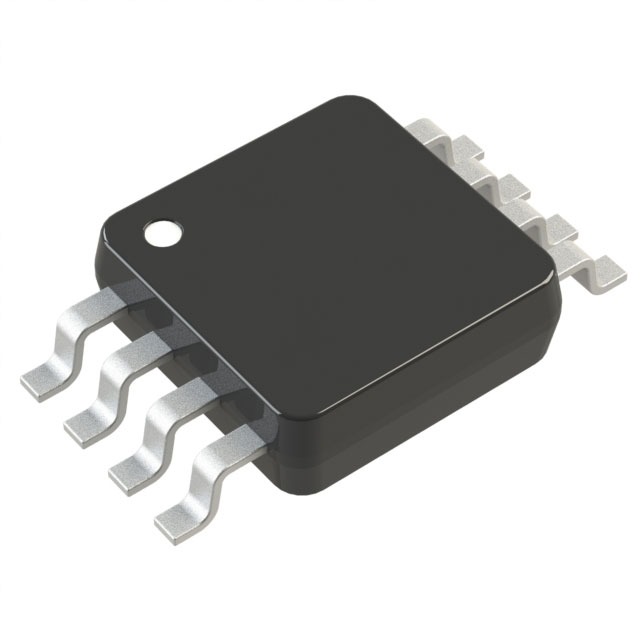ADA4077-2ARMZ-RL
Product Overview
Category: Integrated Circuit (IC)
Use: The ADA4077-2ARMZ-RL is a dual operational amplifier designed for precision applications. It is commonly used in various electronic circuits where accurate amplification and signal conditioning are required.
Characteristics: - Low offset voltage and low input bias current - High open-loop gain and bandwidth - Rail-to-rail input and output capability - Low noise and distortion - Wide supply voltage range
Package: The ADA4077-2ARMZ-RL comes in a small outline package (SOIC) with 8 pins.
Essence: This IC is essential for amplifying weak signals accurately and efficiently, making it suitable for applications that demand high precision and performance.
Packaging/Quantity: The ADA4077-2ARMZ-RL is typically sold in reels or tubes, containing a specific quantity of ICs per package.
Specifications
- Supply Voltage Range: ±2 V to ±18 V
- Input Offset Voltage: 50 µV (maximum)
- Input Bias Current: 1 nA (maximum)
- Open-Loop Gain: 120 dB (typical)
- Bandwidth: 10 MHz (typical)
- Slew Rate: 5 V/µs (typical)
- Total Harmonic Distortion: 0.001% (typical)
Pin Configuration
The ADA4077-2ARMZ-RL has the following pin configuration:
___________
OUT1 | 1 8 | V+
IN1- | 2 7 | V-
IN1+ | 3 6 | OUT2
V- | 4 5 | IN2+
‾‾‾‾‾‾‾‾‾‾‾
Functional Features
- Dual operational amplifier with independent inputs and outputs
- High precision and accuracy in amplification
- Wide input voltage range
- Low power consumption
- Stable operation under varying load conditions
- Protection against overvoltage and short circuits
Advantages and Disadvantages
Advantages: - Low offset voltage ensures accurate signal amplification - Rail-to-rail input and output capability allows for maximum signal swing - High open-loop gain and bandwidth enable precise signal conditioning - Low noise and distortion result in high-quality output signals - Wide supply voltage range provides flexibility in various applications
Disadvantages: - Relatively higher cost compared to standard operational amplifiers - Limited availability in certain markets or regions
Working Principles
The ADA4077-2ARMZ-RL operates based on the principles of operational amplifiers. It utilizes differential input stages, feedback mechanisms, and internal compensation to achieve high precision amplification and signal conditioning. The IC is designed to minimize offset voltage, input bias current, and other non-ideal characteristics that could affect the accuracy of the amplified signal.
Detailed Application Field Plans
The ADA4077-2ARMZ-RL finds extensive use in various fields, including but not limited to: 1. Precision instrumentation and measurement equipment 2. Audio amplification and signal processing systems 3. Sensor signal conditioning circuits 4. Industrial control systems 5. Medical devices and diagnostic equipment 6. Communication systems 7. Automotive electronics
Detailed and Complete Alternative Models
- AD8628ARZ - Single Operational Amplifier with similar specifications
- AD8676ARZ - Dual Operational Amplifier with lower offset voltage
- AD8065ARTZ - Dual Operational Amplifier with higher bandwidth
- AD822ARZ - Dual Operational Amplifier with lower power consumption
- AD823ANZ - Dual Operational Amplifier with rail-to-rail input and output
These alternative models offer similar functionality and can be considered as substitutes for the ADA4077-2ARMZ-RL based on specific application requirements.
Word count: 439 words
Senaraikan 10 soalan dan jawapan biasa yang berkaitan dengan aplikasi ADA4077-2ARMZ-RL dalam penyelesaian teknikal
Sure! Here are 10 common questions and answers related to the application of ADA4077-2ARMZ-RL in technical solutions:
Q: What is ADA4077-2ARMZ-RL? A: ADA4077-2ARMZ-RL is a low-power, precision operational amplifier designed for various applications in technical solutions.
Q: What is the supply voltage range for ADA4077-2ARMZ-RL? A: The supply voltage range for ADA4077-2ARMZ-RL is typically between 2.7V and 5.5V.
Q: What is the input offset voltage of ADA4077-2ARMZ-RL? A: The input offset voltage of ADA4077-2ARMZ-RL is typically very low, around 0.25mV.
Q: Can ADA4077-2ARMZ-RL operate in single-supply configurations? A: Yes, ADA4077-2ARMZ-RL can operate in both single-supply and dual-supply configurations.
Q: What is the typical gain bandwidth product of ADA4077-2ARMZ-RL? A: The typical gain bandwidth product of ADA4077-2ARMZ-RL is around 10MHz.
Q: Is ADA4077-2ARMZ-RL suitable for low-power applications? A: Yes, ADA4077-2ARMZ-RL is designed to be low-power, making it suitable for battery-powered or energy-efficient applications.
Q: Can ADA4077-2ARMZ-RL drive capacitive loads? A: Yes, ADA4077-2ARMZ-RL has a high output current capability, allowing it to drive capacitive loads without significant degradation in performance.
Q: What is the input bias current of ADA4077-2ARMZ-RL? A: The input bias current of ADA4077-2ARMZ-RL is typically very low, around 1nA.
Q: Can ADA4077-2ARMZ-RL operate at high temperatures? A: Yes, ADA4077-2ARMZ-RL has a wide temperature range and can operate reliably at high temperatures up to 125°C.
Q: What are some common applications for ADA4077-2ARMZ-RL? A: ADA4077-2ARMZ-RL is commonly used in precision instrumentation, sensor signal conditioning, data acquisition systems, and other low-power analog signal processing applications.
Please note that the answers provided here are general and may vary depending on specific datasheet specifications and application requirements.


